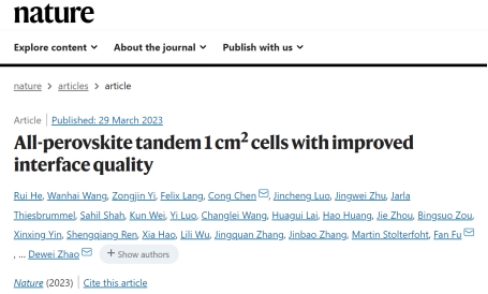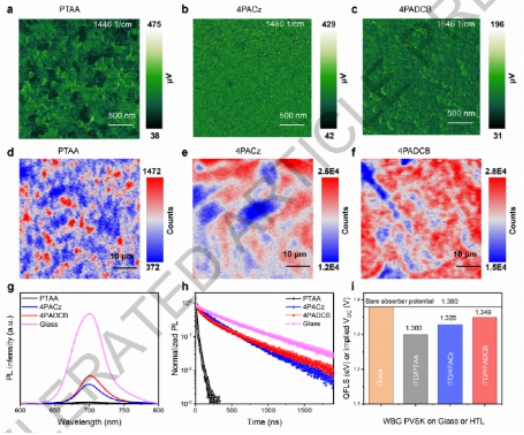Recently, the research team on optoelectronic materials and devices from the School of Resources, Environment and Materials of our university, including Professor Zou Bingsuo and Assistant Professor Huang Hao, in collaboration with institutions such as Sichuan University and Xiamen University, published their research findings on “All-perovskite tandem 1 cm2 cells with improved interface quality” in the journal Nature.

This study developed a self-assembled monolayer (SAM) with a phosphonic acid group, named 4PADCB, as a hole transport material based on the conjugated extension and anchoring strategy. The unique spatially twisted structure of the SAM molecules provided good film-forming and surface-wetting properties, which were beneficial for the growth of large-area high-quality wide-bandgap perovskite thin films. Meanwhile, the extended conjugation range and ordered molecular arrangement enhanced the interface charge extraction and transport capabilities, significantly suppressing nonradiative recombination losses of charge carriers at the interface in wide-bandgap perovskite solar cells. These advantages greatly increased the open-circuit voltage (VOC) and fill factor (FF) of the wide-bandgap cells and significantly improved the operational stability of the devices. Through optimization, the highest efficiency of the wide-bandgap perovskite solar cell (aperture area of 1.044 square centimeters) reached 18.46%. Based on this wide-bandgap cell, a full perovskite tandem solar cell achieved a world-record efficiency of 26.4%, certified by the Japan Electrical Safety & Environment Technology Laboratories (JET), and included in the authoritative “Solar cell efficiency tables”. Additionally, this work used multiple advanced characterization techniques to investigate and analyze the physical mechanisms of performance improvements of wide-bandgap perovskite solar cells and full perovskite tandem devices, providing profound insights into the efficiency and stability improvement of large-area wide-bandgap perovskite and full perovskite tandem solar cells and new ideas for the design of novel and efficient hole transport materials.

In this research, the team from the School of Resources, Environment and Materials of our university provided support in characterizing the quality of the monolayer, and provided experimental evidence for the important role of monolayer quality in solar cells through photo-induced force microscopy (PiFM).
 Home
>
News & Events
>
News
Home
>
News & Events
>
News
 Home
>
News & Events
>
News
Home
>
News & Events
>
News




